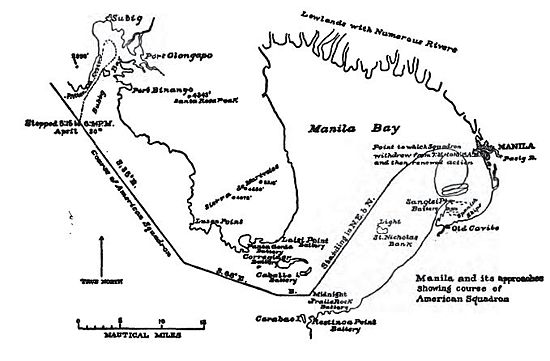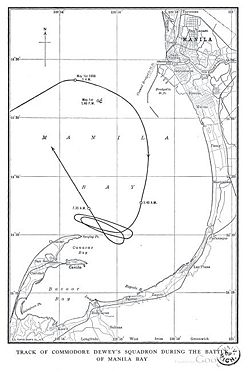George Dewey
George Dewey (1837-1917) was an American admiral, and the naval hero of the Spanish-American War of 1898.
Career
Dewey was born in Montpelier, Vermont, Dec. 26, 1837. He attended the U.S. Naval Academy in Annapolis and in 1858 was graduated fifth in a class of fifteen. From 1858 to 1861 he served on various sail and stream-driven ships.
Civil War
At the beginning of the Civil War, Dewey was assigned as executive officer of the side-wheeler Mississippi a unit of Admiral David G. Farragut's squadron in the New Orleans campaign. While navigating the ship during her run past the forts, Dewey managed by quick maneuvering to avoid the full force of a ramming attack by the Confederate ship Manassas, thus saving the Mississippi from serious damage. The next year, however, in an attempt to pass the Confederate stronghold of Port Hudson, Louisiana, the Mississippi ran aground and had to be destroyed. Dewey saw further service on Farragut's temporary flagship, the Monongahela, and as gunnery officer on the Colorado in the bombardment of Fort Fisher.
Dewey served at the Naval Academy, surveying expedition off the California coast, on lighthouse duty, and on the European station. Promoted to captain in 1884, he was appointed chief of the Bureau of Equipment in 1889, and in 1895 Dewey became president of the Board of Inspection and Survey, witnessing the trials of ships of the new navy.
Spanish American War
In 1897, on the eve of the Spanish American War, Assistant Secretary of the Navy Theodore Roosevelt had Dewey appointed to command the Asiatic Squadron, which he quickly brought to a high level of discipline and readiness. He took vigorous measures to transport ammunition to the Far East and set up an advanced base at Mirs Bay, on the coast of China, 600 miles from Manila.
After the battleship USS Maine mysteriously exploded in Havana harbor on February 25, 1898, war loomed closer. Roosevelt immediately cabled Commodore Dewey in Hong Kong: "Keep full of coal. In the event of declaration of war with Spain, your duty will be to see that the Spanish Squadron does not leave the Asiatic coast and then offensive operations in Philippine Islands." Dewey bought the coal, drilled his crews, refited his fleet, and keep in close touch with the American consul in Manila. When on April 26, 1898, telegrams brought news that war had been declared, he sailed promptly for Manila Bay to attack the Spanish fleet.
The Spanish fleet in Manila Bay consisted of seven old undergunned warships. Dewey had six modern warships; they had no armor. The entrance to the bay was guarded by three islands fortified with 17 rifled guns. The two channels were reported to be mined. Even if Dewey's squadron managed to get past the island forts and mines, the Spanish ships inside the huge bay, which is 30 miles across. were backed up by 37 shore batteries with heavy guns. When foreign naval officers in Hong Kong learned about Dewey's new mission, they thought he was headed for certain destruction and drank farewell toasts to the doomed Americans. Dewey's fleet had 53 guns larger than 4-inchers; Montojo had only 31. More important, Dewey had ten 8-inch guns while Montojo had none. The difference in range and destructive power gave Dewey an overwhelming advantage.
Dewey passed the islands in the dark; the Spanish gunners were asleep and got off only a few shots, all wide of the mark. Dewey sailed boldly into Manila Bay, ignoring the mines. Dewey figured correctly that in the tropical waters the mines had deteriorated and that their number was probably exaggerated. "I have waited 60 years for this opportunity," said Dewey. "Mines or no mines, I am leading the squadron in myself." Dewey's aggressiveness dismayed Admiral Patricio Montojo's Far Eastern fleet at anchor off Cavite, south of Manila. He and his men knew the island defenses and mine ruse had failed and that their weak guns were useless. Montojo later claimed he went there because the waters off Cavite were so shallow (7 to 26 feet) that if his ships were sunk, his men could save themselves by swimming ashore. Cavite had shore batteries, but fewer guns with shorter ranges than at Manila, and the gunnery was poor. Dewey had 1,743 sailors men to Montojo's 1,130.
In his flagship Olympia, at dawn on May 1, Dewey led his line of six cruisers in attack on an elliptical course that paralleled the enemy at varying ranges. He closed to 5,500 yards, the effective range for his 8-inch guns. At 5:40 A.M. as the Olympia steamed broadside to the first Spanish ship, Dewey told the Olympia's captain, "You may fire when you are ready, Gridley." Dewey's nonchalance and confidence made him a celebrity. Dewey broke for resupply (and breakfast) at 7:30 then resumed the attack. All the Spanish ships were destroyed, while not one American sailor was killed, and only eight slightly injured. The Olympia was hulled five times and her rigging cut, the Baltimore was hit five times, and the Boston and the Petrel received some unimportant hits. The Spaniards had 167 sailors killed and 214 wounded. Dewey's fleet now commanded the harbor, and he told a German fleet to stay back. The Spanish army with 15,000 was trapped as Dewey set up a blockade.
On August 13, 1898, Dewey collaborated with Gen. Wesley Merritt in an amphibious landing and capture of the city of Manila. He remained in the Philippines for a year, cooperating with the army in efforts to suppress Filipino uprisings.
Hero
The totality of Dewey's victory brought the world to a sharp awareness of the United States as a naval power. Returning to the United States in 1899, he received a hero's welcome. New York City's September 1899 welcome home celebration for Dewey was a two-day parade served more to promote the potential of American colonialism in Asia than to honor Dewey's heroism in the Philippines. Newspapers transformed Dewey into the epitome of American superiority by highlighting his leadership capabilities and accentuating the strength and masculinity of his features.
The U.S. Congress revived the title of Admiral of the Navy--previously held by only two men--and awarded it to Dewey. In 1900 he was named president of the newly established General Board of the Navy Department, which set basic policy. He served in this post until his death in Washington, January 16, 1917.
Dewey was energetic, competent and vain. He wore spiffy clothes and a glorious handlebar mustache; thanks to inherited wealth he lived in style. He often went horseback riding with Roosevelt in Washington's Rock Creek Park and he was a fellow member of Washington's prestigious Metropolitan Club. Dewey fit the nation's need for a hero, but he was not an innovator, for he invented no new weapons or techniques, planned and executed only one great campaigns, and contributed no new strategic insights to the navy.
With the collaboration of journalist Frederick Palmer as ghostwriter, who used the reports of Dewey's aide, Nathan Sargent, his autobiography appeared in 1913.

